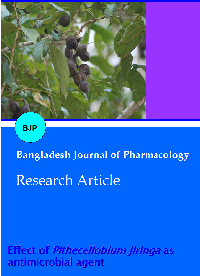Effect of Pithecellobium jiringa as antimicrobial agent
DOI:
https://doi.org/10.3329/bjp.v7i2.10973Keywords:
Antibacterial, Antifungal, Pithecellobium jiringaAbstract
Pithecellobium jiringa is Malay traditional local delicacy. There is no local data on antimicrobial nature of P. jiringa is available. The objective of our study was to evaluate the antimicrobial activity of P. jiringa. Leaves, pods and seeds of P. jiringa were extracted using methanol. Ten test microorganisms were used in the study. The disc diffusion assay was used to determine the sensitivity of the samples, while the liquid dilution method was used for the determination of the minimal inhibition concentration (MIC). Chloramphenicol was used as a reference standard. The results revealed that all extracts of P. jiringa showed the antimicrobial and antifungal activities against the test organisms. Amongst the active extracts, the minimal inhibition concentration (MIC) determination showed that the extract of P. jiringa leaf was the most active against S. aureus, S. epidermidis and M. gypsum (100 mg/mL). The results provided evidence that the studied plants extract might be potential sources of new antimicrobial drug.
Downloads
545
386 Read
20
References
Allen ON, Allen EK. The leguminosae: A source book of characteristics, uses and modulation. Wisconsin, Wisconsin Press, 1981.
Areekul S, Kirdudom P, Chaovanapricha K. Studies on djenkol bean poisoning (djenkolism) in experimental animals. Southeast Asian J Trop Med Public Health. 1976; 7: 55158.
Cragg GM, Newman DJ. Drugs from nature: Past achievements, future prospects. In: Ethnomedicine and drug discovery. Iwu MM, Wootton JC (eds). Amsterdam, Elsevier Science, 2002, pp 23-37.
Cordell GA. Biodiversity and drug discovery a symbiotic relationship. Phytochemistry 2000; 55: 463-80.
Corner EJH. Wayside trees of Malaya. Vol 1. Singapore, Government Printing Office, 1988, pp 396464.
Cowan MM. Plant products as antimicrobial agents. Clin Microbiol Rev. 1999; 12: 56482.
El-Mahmood AM, Doughari JH, Ladan N. Antimicrobial screening of stem bark extracts of Vitellaria paradoxa against some enteric pathogenic micro-organisms. Afr J Pharm Pharmacol. 2008; 2: 89-94.
Gordon MC, David JN. Natural product drug discovery in the next millennium. Pharmaceut Biol. 2001; 139: 817.
Harborne, J.B. Phytochemistry of the Leguminosae. In: Phytochemical dictionary of the Leguminosae. Bisby F.A. (ed) London, Chapman & Hall, 1994.
Lee MW, Morimoto S, Nonaka GJ, Nishioka J. Flavon 3-ol gallates and proanthocyanidines from Pithecellobium lobatum. Phytochemistry 1992; 31: 2117-20.
Mohamed S, Rahman MSA, Sulaiman S. Some nutritional and anti-nutritional components in jering Pithecellobium-jeringa, keredas Pithecellobium-microcarpum and petai Parkia-speciosa. Pertanika 1987; 10: 6168.
Parekh J, Karathia N, Chanda S. Screening of some traditionally used medicinal plants for potential antibacterial activity. Indian J Pharm Sci. 2006; 68: 832-34.
Zaika LL. Spices and herbs: Their antimicrobial activity and its determination. J Food Safety. 1975; 9: 97118.

Published
How to Cite
Issue
Section
License
Authors who publish with this journal agree to the following terms:
- Authors retain copyright and grant the journal right of first publication with the work simultaneously licensed under a Creative Commons Attribution License that allows others to share the work with an acknowledgement of the work's authorship and initial publication in this journal.
- Authors are able to enter into separate, additional contractual arrangements for the non-exclusive distribution of the journal's published version of the work (e.g., post it to an institutional repository or publish it in a book), with an acknowledgement of its initial publication in this journal.
- Authors are permitted and encouraged to post their work online (e.g., in institutional repositories or on their website) prior to and during the submission process, as it can lead to productive exchanges, as well as earlier and greater citation of published work (See The Effect of Open Access).
